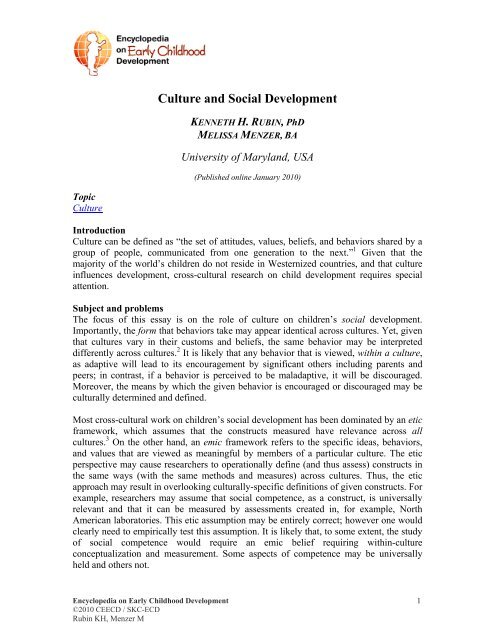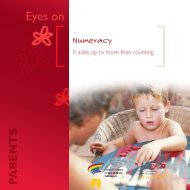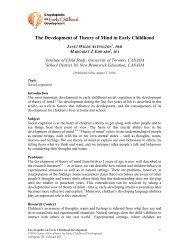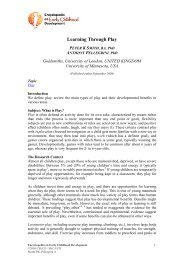Culture and social development - Encyclopedia on Early Childhood ...
Culture and social development - Encyclopedia on Early Childhood ...
Culture and social development - Encyclopedia on Early Childhood ...
You also want an ePaper? Increase the reach of your titles
YUMPU automatically turns print PDFs into web optimized ePapers that Google loves.
Topic<br />
<str<strong>on</strong>g>Culture</str<strong>on</strong>g><br />
<str<strong>on</strong>g>Culture</str<strong>on</strong>g> <str<strong>on</strong>g>and</str<strong>on</strong>g> Social Development<br />
KENNETH H. RUBIN, PhD<br />
MELISSA MENZER, BA<br />
University of Maryl<str<strong>on</strong>g>and</str<strong>on</strong>g>, USA<br />
(Published <strong>on</strong>line January 2010)<br />
Introducti<strong>on</strong><br />
<str<strong>on</strong>g>Culture</str<strong>on</strong>g> can be defined as “the set of attitudes, values, beliefs, <str<strong>on</strong>g>and</str<strong>on</strong>g> behaviors shared by a<br />
group of people, communicated from <strong>on</strong>e generati<strong>on</strong> to the next.” 1 Given that the<br />
majority of the world’s children do not reside in Westernized countries, <str<strong>on</strong>g>and</str<strong>on</strong>g> that culture<br />
influences <str<strong>on</strong>g>development</str<strong>on</strong>g>, cross-cultural research <strong>on</strong> child <str<strong>on</strong>g>development</str<strong>on</strong>g> requires special<br />
attenti<strong>on</strong>.<br />
Subject <str<strong>on</strong>g>and</str<strong>on</strong>g> problems<br />
The focus of this essay is <strong>on</strong> the role of culture <strong>on</strong> children’s <str<strong>on</strong>g>social</str<strong>on</strong>g> <str<strong>on</strong>g>development</str<strong>on</strong>g>.<br />
Importantly, the form that behaviors take may appear identical across cultures. Yet, given<br />
that cultures vary in their customs <str<strong>on</strong>g>and</str<strong>on</strong>g> beliefs, the same behavior may be interpreted<br />
differently across cultures. 2 It is likely that any behavior that is viewed, within a culture,<br />
as adaptive will lead to its encouragement by significant others including parents <str<strong>on</strong>g>and</str<strong>on</strong>g><br />
peers; in c<strong>on</strong>trast, if a behavior is perceived to be maladaptive, it will be discouraged.<br />
Moreover, the means by which the given behavior is encouraged or discouraged may be<br />
culturally determined <str<strong>on</strong>g>and</str<strong>on</strong>g> defined.<br />
Most cross-cultural work <strong>on</strong> children’s <str<strong>on</strong>g>social</str<strong>on</strong>g> <str<strong>on</strong>g>development</str<strong>on</strong>g> has been dominated by an etic<br />
framework, which assumes that the c<strong>on</strong>structs measured have relevance across all<br />
cultures. 3 On the other h<str<strong>on</strong>g>and</str<strong>on</strong>g>, an emic framework refers to the specific ideas, behaviors,<br />
<str<strong>on</strong>g>and</str<strong>on</strong>g> values that are viewed as meaningful by members of a particular culture. The etic<br />
perspective may cause researchers to operati<strong>on</strong>ally define (<str<strong>on</strong>g>and</str<strong>on</strong>g> thus assess) c<strong>on</strong>structs in<br />
the same ways (with the same methods <str<strong>on</strong>g>and</str<strong>on</strong>g> measures) across cultures. Thus, the etic<br />
approach may result in overlooking culturally-specific definiti<strong>on</strong>s of given c<strong>on</strong>structs. For<br />
example, researchers may assume that <str<strong>on</strong>g>social</str<strong>on</strong>g> competence, as a c<strong>on</strong>struct, is universally<br />
relevant <str<strong>on</strong>g>and</str<strong>on</strong>g> that it can be measured by assessments created in, for example, North<br />
American laboratories. This etic assumpti<strong>on</strong> may be entirely correct; however <strong>on</strong>e would<br />
clearly need to empirically test this assumpti<strong>on</strong>. It is likely that, to some extent, the study<br />
of <str<strong>on</strong>g>social</str<strong>on</strong>g> competence would require an emic belief requiring within-culture<br />
c<strong>on</strong>ceptualizati<strong>on</strong> <str<strong>on</strong>g>and</str<strong>on</strong>g> measurement. Some aspects of competence may be universally<br />
held <str<strong>on</strong>g>and</str<strong>on</strong>g> others not.<br />
<str<strong>on</strong>g>Encyclopedia</str<strong>on</strong>g> <strong>on</strong> <strong>Early</strong> <strong>Childhood</strong> Development 1<br />
©2010 CEECD / SKC-ECD<br />
Rubin KH, Menzer M
CULTURE<br />
Research C<strong>on</strong>text<br />
In additi<strong>on</strong> to culture, other significant c<strong>on</strong>structs need to be addressed. For example,<br />
broadly, researchers typically discuss two cultural phenomena: 1) independent,<br />
individualistic, or Western cultures, <str<strong>on</strong>g>and</str<strong>on</strong>g> 2) interdependent, collectivistic, or Eastern <str<strong>on</strong>g>and</str<strong>on</strong>g><br />
Southern (e.g., Central <str<strong>on</strong>g>and</str<strong>on</strong>g> South American) cultures. Western cultures are often<br />
described as those for whom members value assertiveness, expressiveness <str<strong>on</strong>g>and</str<strong>on</strong>g><br />
competitiveness; whereas Eastern <str<strong>on</strong>g>and</str<strong>on</strong>g> Southern cultures are often described as those for<br />
whom members value group harm<strong>on</strong>y <str<strong>on</strong>g>and</str<strong>on</strong>g> cooperati<strong>on</strong>. More recently, there has been<br />
agreement that most countries are a fine mix of both of these c<strong>on</strong>structs, with some being<br />
relatively more individualistic <str<strong>on</strong>g>and</str<strong>on</strong>g> others relatively more collectivistic. Significantly, in<br />
the research area reviewed herein, there is relatively little known of Southern cultures (or<br />
differences between Northern <str<strong>on</strong>g>and</str<strong>on</strong>g> Southern cultures); thus, the review is focused mainly<br />
<strong>on</strong> comparis<strong>on</strong>s between Western <str<strong>on</strong>g>and</str<strong>on</strong>g> Eastern cultures.<br />
Key Research Questi<strong>on</strong>s<br />
1) What defines <str<strong>on</strong>g>social</str<strong>on</strong>g> competence in Western, Eastern, Northern <str<strong>on</strong>g>and</str<strong>on</strong>g> Southern<br />
cultures?<br />
2) How do peers react to children <str<strong>on</strong>g>and</str<strong>on</strong>g> adolescents who fail to c<strong>on</strong>form to cultural<br />
norms of <str<strong>on</strong>g>social</str<strong>on</strong>g> competence?<br />
3) How do individual characteristics, <str<strong>on</strong>g>social</str<strong>on</strong>g> interacti<strong>on</strong>s <str<strong>on</strong>g>and</str<strong>on</strong>g> relati<strong>on</strong>ships, groups<br />
<str<strong>on</strong>g>and</str<strong>on</strong>g> culture interact to influence <str<strong>on</strong>g>social</str<strong>on</strong>g> <str<strong>on</strong>g>development</str<strong>on</strong>g>?<br />
Recent Research Results<br />
Individual Characteristics <str<strong>on</strong>g>and</str<strong>on</strong>g> Interacti<strong>on</strong>s<br />
Temperament. Generally defined, temperament is the biological basis of pers<strong>on</strong>ality. 4<br />
Research <strong>on</strong> the topic of temperamentally-based <str<strong>on</strong>g>social</str<strong>on</strong>g>ly wary, reticent <str<strong>on</strong>g>and</str<strong>on</strong>g> inhibited<br />
behavior has reported differences in prevalence of this c<strong>on</strong>struct between East Asian<br />
(e.g., China, South Korea) <str<strong>on</strong>g>and</str<strong>on</strong>g> Western children <str<strong>on</strong>g>and</str<strong>on</strong>g> youth (e.g., Western Europe,<br />
Canada <str<strong>on</strong>g>and</str<strong>on</strong>g> the United States); the former group has dem<strong>on</strong>strated a higher prevalence of<br />
wary, inhibited behavior than the latter. 5,6,7,8,9 In Western cultures, which value<br />
independence <str<strong>on</strong>g>and</str<strong>on</strong>g> assertiveness, <str<strong>on</strong>g>social</str<strong>on</strong>g>ly-inhibited <str<strong>on</strong>g>and</str<strong>on</strong>g> reticent behavior is viewed as<br />
reflecting shyness, fearfulness <str<strong>on</strong>g>and</str<strong>on</strong>g> <str<strong>on</strong>g>social</str<strong>on</strong>g> incompetence; in East Asian cultures, which are<br />
dominated historically by C<strong>on</strong>fucian <str<strong>on</strong>g>and</str<strong>on</strong>g> Taoist philosophies, <str<strong>on</strong>g>social</str<strong>on</strong>g>ly wary <str<strong>on</strong>g>and</str<strong>on</strong>g> inhibited<br />
behavior is viewed as reflecting compliance, obedience, being well-mannered, <str<strong>on</strong>g>and</str<strong>on</strong>g> thus,<br />
<str<strong>on</strong>g>social</str<strong>on</strong>g> maturity <str<strong>on</strong>g>and</str<strong>on</strong>g> accomplishment. 10<br />
Pro<str<strong>on</strong>g>social</str<strong>on</strong>g> behavior. In general, pro<str<strong>on</strong>g>social</str<strong>on</strong>g> (helping, sharing, caring, politeness) behaviors<br />
increase during the course of childhood, although the <str<strong>on</strong>g>development</str<strong>on</strong>g> <str<strong>on</strong>g>and</str<strong>on</strong>g> prevalence of<br />
pro<str<strong>on</strong>g>social</str<strong>on</strong>g> behaviors varies across cultures. 11 For example, researchers find that pro<str<strong>on</strong>g>social</str<strong>on</strong>g><br />
behavior, as observed am<strong>on</strong>g peers <str<strong>on</strong>g>and</str<strong>on</strong>g> in parent-child interacti<strong>on</strong> is more prevalent<br />
am<strong>on</strong>g young East Asian children than am<strong>on</strong>g Western children. Researchers suggest that<br />
this difference results from the collectivist ideologies prevalent in East Asian cultures. In<br />
support of this c<strong>on</strong>tenti<strong>on</strong>, researchers have reported that Chinese mothers of<br />
preschoolers are more likely than European American mothers to believe that their<br />
preschool children should share <str<strong>on</strong>g>and</str<strong>on</strong>g> help other children for <str<strong>on</strong>g>social</str<strong>on</strong>g> c<strong>on</strong>venti<strong>on</strong>al reas<strong>on</strong>s<br />
(e.g., to fit in with the group <str<strong>on</strong>g>and</str<strong>on</strong>g> functi<strong>on</strong> well in Chinese society). 12<br />
<str<strong>on</strong>g>Encyclopedia</str<strong>on</strong>g> <strong>on</strong> <strong>Early</strong> <strong>Childhood</strong> Development 2<br />
©2010 CEECD / SKC-ECD<br />
Rubin KH, Menzer M
CULTURE<br />
Cooperati<strong>on</strong>/competiti<strong>on</strong>. Whereas competiti<strong>on</strong> can damage group harm<strong>on</strong>y, cooperati<strong>on</strong><br />
is necessary in relati<strong>on</strong>ship maintenance. 13 Children from interdependent communities<br />
are more cooperative <str<strong>on</strong>g>and</str<strong>on</strong>g> less competitive than those from Westernized cultures.<br />
However, competiti<strong>on</strong> <str<strong>on</strong>g>and</str<strong>on</strong>g> cooperati<strong>on</strong> appear to co-exist regardless of culture. For<br />
example, in East Asian nati<strong>on</strong>s, children are more cooperative with friends <str<strong>on</strong>g>and</str<strong>on</strong>g> family,<br />
but more competitive in educati<strong>on</strong>al c<strong>on</strong>texts. 14 Further, generati<strong>on</strong>al differences appear<br />
to exist within cultures. For example, third-generati<strong>on</strong> Mexican Americans are more<br />
competitive than their sec<strong>on</strong>d-generati<strong>on</strong> counterparts. 15<br />
Aggressi<strong>on</strong>. Physical, verbal <str<strong>on</strong>g>and</str<strong>on</strong>g> relati<strong>on</strong>al aggressi<strong>on</strong> have been identified as distinct<br />
entities in many cultures <str<strong>on</strong>g>and</str<strong>on</strong>g> countries. 16,17,18,19,20 Typically, physical aggressi<strong>on</strong> is<br />
viewed as unacceptable by parents <str<strong>on</strong>g>and</str<strong>on</strong>g> is associated with peer rejecti<strong>on</strong> in most<br />
countries. 21,22,16,23,24,25,8,26 Nevertheless, meta-analyses have dem<strong>on</strong>strated that cultures<br />
characterized by collectivistic <str<strong>on</strong>g>and</str<strong>on</strong>g> C<strong>on</strong>fucian values generally show lower levels of<br />
aggressi<strong>on</strong>, regardless of type, towards peers than their Western counterparts. 27<br />
Social withdrawal. There is increasing evidence that fearful, wary, inhibited behavior<br />
am<strong>on</strong>g toddlers predicts early childhood <str<strong>on</strong>g>social</str<strong>on</strong>g> reticence <str<strong>on</strong>g>and</str<strong>on</strong>g> anxiety. 9 Although inhibited<br />
toddlers in North America <str<strong>on</strong>g>and</str<strong>on</strong>g> East Asia are at increased risk for <str<strong>on</strong>g>social</str<strong>on</strong>g> reticence as<br />
preschoolers, the prevalence of reticent behavior is higher am<strong>on</strong>g East Asian than<br />
Western children. 28 Relatedly, young Western children are more sociable (i.e., friendly<br />
<str<strong>on</strong>g>and</str<strong>on</strong>g> outgoing) than their East Asian counterparts.<br />
Peer relati<strong>on</strong>ships: Friendships<br />
Friendship is often referred to as a close, mutual <str<strong>on</strong>g>and</str<strong>on</strong>g> voluntary dyadic relati<strong>on</strong>ship. The<br />
voluntary nature of friendships means that children are able to initiate, maintain <str<strong>on</strong>g>and</str<strong>on</strong>g><br />
relinquish friendships that meet their expectati<strong>on</strong>s <str<strong>on</strong>g>and</str<strong>on</strong>g>/or needs. However, the noti<strong>on</strong> that<br />
friendship is a voluntary, freely-chosen relati<strong>on</strong>ship may not be the case in all cultures. 29<br />
In some cultures, children rarely engage in n<strong>on</strong>-familial friendships. For example,<br />
children in traditi<strong>on</strong>al Yucatec Mayan communities spend most of their time with their<br />
immediate <str<strong>on</strong>g>and</str<strong>on</strong>g> extended family. 30<br />
From a Western perspective, researchers have argued that friendship serves different<br />
functi<strong>on</strong>s for children at different points in <str<strong>on</strong>g>development</str<strong>on</strong>g>. 31 For example, young children’s<br />
friendships serve to maximize excitement <str<strong>on</strong>g>and</str<strong>on</strong>g> amusement during play <str<strong>on</strong>g>and</str<strong>on</strong>g> to aid in the<br />
organizati<strong>on</strong> of behavior. Little is known, however, about the <str<strong>on</strong>g>development</str<strong>on</strong>g>al course of<br />
the functi<strong>on</strong>s of friendship across cultures. Moreover, the functi<strong>on</strong>s <str<strong>on</strong>g>and</str<strong>on</strong>g> nature of<br />
friendship appear to vary across cultures. In cultures within which friendships are<br />
c<strong>on</strong>sidered <strong>on</strong>e of very few relati<strong>on</strong>ships guaranteeing societal success, both intimacy <str<strong>on</strong>g>and</str<strong>on</strong>g><br />
exclusivity should be regarded as the most important aspects of a friendship. 32 Reflecting<br />
this idea, researchers have found that intimacy is more important in the friendships of<br />
children in Korea <str<strong>on</strong>g>and</str<strong>on</strong>g> Cuba than in those of North American children. 33,34<br />
It is also the case that across cultures, friends spend more time together than n<strong>on</strong>-friends;<br />
<strong>on</strong>e outcome is that friends are often observed to engage in more c<strong>on</strong>flict than unfamiliar<br />
peers or mere acquaintances. 35 If appropriately resolved, c<strong>on</strong>flict can positively affect<br />
<str<strong>on</strong>g>Encyclopedia</str<strong>on</strong>g> <strong>on</strong> <strong>Early</strong> <strong>Childhood</strong> Development 3<br />
©2010 CEECD / SKC-ECD<br />
Rubin KH, Menzer M
CULTURE<br />
<str<strong>on</strong>g>development</str<strong>on</strong>g>al growth. 36 However, c<strong>on</strong>flict is resolved differently across cultures.<br />
Researchers have reported that negotiati<strong>on</strong> is often used to resolve c<strong>on</strong>flict am<strong>on</strong>g<br />
Western children; whereas disengagement appears to be favored am<strong>on</strong>g Eastern<br />
cultures. 37<br />
From an early age, most children form friendships with those who are similar to<br />
themselves in observable characteristics, such as age, sex, ethnicity, <str<strong>on</strong>g>and</str<strong>on</strong>g> behavioral<br />
proclivities. Even children of preschool age are more likely to choose play partners who<br />
are similar to them in age, sex, ethnicity <str<strong>on</strong>g>and</str<strong>on</strong>g> behavior. 38,39<br />
The group: Peer acceptance <str<strong>on</strong>g>and</str<strong>on</strong>g> rejecti<strong>on</strong><br />
Young, <str<strong>on</strong>g>social</str<strong>on</strong>g>ly-accepted children are typically skilled at initiating <str<strong>on</strong>g>and</str<strong>on</strong>g> maintaining<br />
positive relati<strong>on</strong>ships, <str<strong>on</strong>g>and</str<strong>on</strong>g> are viewed by peers <str<strong>on</strong>g>and</str<strong>on</strong>g> teachers as cooperative, sociable <str<strong>on</strong>g>and</str<strong>on</strong>g><br />
sensitive. These findings cut across cultures: friendly children tend to be accepted by<br />
peers across cultures; <strong>on</strong> the other h<str<strong>on</strong>g>and</str<strong>on</strong>g>, researchers have found that across cultures,<br />
immature, <str<strong>on</strong>g>social</str<strong>on</strong>g>ly unskilled <str<strong>on</strong>g>and</str<strong>on</strong>g> aggressive preschoolers are rejected by their<br />
peers. 21,40,41,42,22,16,23,24,25,8,20,26<br />
In Westernized c<strong>on</strong>texts, <str<strong>on</strong>g>social</str<strong>on</strong>g> withdrawal has been linked to peer rejecti<strong>on</strong>. 40,22,43,44 But<br />
recent findings have revealed that <str<strong>on</strong>g>social</str<strong>on</strong>g> withdrawal is also associated with rejecti<strong>on</strong><br />
am<strong>on</strong>g children in India <str<strong>on</strong>g>and</str<strong>on</strong>g> industrialized China. 45,8 Thus, the correlates of peer<br />
acceptance <str<strong>on</strong>g>and</str<strong>on</strong>g> rejecti<strong>on</strong> across cultures appear to be similar. Both aggressiveness <str<strong>on</strong>g>and</str<strong>on</strong>g><br />
withdrawal are associated with rejecti<strong>on</strong>, whereas pro<str<strong>on</strong>g>social</str<strong>on</strong>g> behavior is linked with<br />
acceptance.<br />
Research Gaps<br />
As aforementi<strong>on</strong>ed, a salient problem in cross-cultural work is the belief that an etic<br />
approach is superior to an emic approach. In many respects, such a belief may result<br />
from the accompanying belief that measures created in Western countries can be<br />
“parachuted,” in valid <str<strong>on</strong>g>and</str<strong>on</strong>g> reliable ways, into different countries <str<strong>on</strong>g>and</str<strong>on</strong>g> cultures. To<br />
dem<strong>on</strong>strate the fallacy of this argument, we refer to a <str<strong>on</strong>g>social</str<strong>on</strong>g> competence c<strong>on</strong>struct<br />
specific to China: Ren or forbearance. Ren is a c<strong>on</strong>struct that encourages group harm<strong>on</strong>y.<br />
When young Chinese children use ren in resp<strong>on</strong>se to peer animosity, they disengage<br />
from, rather than do battle with, their peers. 46 This strategy is unlike problem-focused<br />
avoidance because it does not reflect the goal to escape or avoid the <str<strong>on</strong>g>social</str<strong>on</strong>g> situati<strong>on</strong>.<br />
Instead, the goal of ren is to elicit restraint <str<strong>on</strong>g>and</str<strong>on</strong>g> tolerance from the peers with whom they<br />
are interacting. Western researchers may well overlook the <str<strong>on</strong>g>social</str<strong>on</strong>g> c<strong>on</strong>venti<strong>on</strong> of ren <str<strong>on</strong>g>and</str<strong>on</strong>g><br />
thus, may inaccurately c<strong>on</strong>strue <str<strong>on</strong>g>and</str<strong>on</strong>g> assess the c<strong>on</strong>struct of <str<strong>on</strong>g>social</str<strong>on</strong>g> competence in Chinese<br />
culture. Therefore, it would behoove researchers to c<strong>on</strong>sider their cultures of interest, <str<strong>on</strong>g>and</str<strong>on</strong>g><br />
to collaborate with members of those cultures to c<strong>on</strong>ceptualize <str<strong>on</strong>g>and</str<strong>on</strong>g> operati<strong>on</strong>ally define<br />
<str<strong>on</strong>g>social</str<strong>on</strong>g> competence. Al<strong>on</strong>g the way, investigators should c<strong>on</strong>sider how the given c<strong>on</strong>struct<br />
may be defined at different <str<strong>on</strong>g>development</str<strong>on</strong>g>al periods <str<strong>on</strong>g>and</str<strong>on</strong>g> how it evolves both in the short<br />
<str<strong>on</strong>g>and</str<strong>on</strong>g> l<strong>on</strong>g term.<br />
Another c<strong>on</strong>siderati<strong>on</strong> is the study of ethnic subpopulati<strong>on</strong>s within multicultural societies.<br />
For example, in the United States, the East Asian American <str<strong>on</strong>g>and</str<strong>on</strong>g> the Latino American<br />
<str<strong>on</strong>g>Encyclopedia</str<strong>on</strong>g> <strong>on</strong> <strong>Early</strong> <strong>Childhood</strong> Development 4<br />
©2010 CEECD / SKC-ECD<br />
Rubin KH, Menzer M
CULTURE<br />
populati<strong>on</strong>s are c<strong>on</strong>tinually rising in numbers. There is some indicati<strong>on</strong> that immigrant<br />
populati<strong>on</strong>s in these countries hold similar values to their Asian <str<strong>on</strong>g>and</str<strong>on</strong>g> Latin mainl<str<strong>on</strong>g>and</str<strong>on</strong>g><br />
counterparts. 47,15 Yet, for some youth, there appear to be generati<strong>on</strong>al <str<strong>on</strong>g>and</str<strong>on</strong>g> acculturati<strong>on</strong><br />
effects, whereby later generati<strong>on</strong>s are more acculturated to mainstream Westernized<br />
culture than previous generati<strong>on</strong>s. It would benefit researchers to examine the effects of<br />
acculturati<strong>on</strong> in their assessments of cross-cultural or cross-ethnic variability.<br />
C<strong>on</strong>clusi<strong>on</strong><br />
In summary, Western researchers who have interests in cross-cultural studies of young<br />
children’s <str<strong>on</strong>g>social</str<strong>on</strong>g> <str<strong>on</strong>g>development</str<strong>on</strong>g> (<str<strong>on</strong>g>and</str<strong>on</strong>g> <str<strong>on</strong>g>development</str<strong>on</strong>g> in general) would do well to incorporate<br />
into their research programs the expertise of collaborators from other cultures. Only<br />
through c<strong>on</strong>versati<strong>on</strong>s with their collaborators will they develop a better underst<str<strong>on</strong>g>and</str<strong>on</strong>g>ing of<br />
the c<strong>on</strong>structs that truly matter in the lives of children <str<strong>on</strong>g>and</str<strong>on</strong>g> their peers.<br />
Implicati<strong>on</strong>s for Parents, Services <str<strong>on</strong>g>and</str<strong>on</strong>g> Policy<br />
Given that the majority of the world's inhabitants do not reside in culturally<br />
“Westernized” countries, cross-cultural work <strong>on</strong> the study of <str<strong>on</strong>g>social</str<strong>on</strong>g> <str<strong>on</strong>g>development</str<strong>on</strong>g> bears<br />
careful note. From our example of <str<strong>on</strong>g>social</str<strong>on</strong>g> inhibiti<strong>on</strong> or reticence, <strong>on</strong>e can begin to<br />
underst<str<strong>on</strong>g>and</str<strong>on</strong>g> that behaviors, when exhibited across cultural settings may take the same<br />
form; however, the functi<strong>on</strong> of these behaviors varies from culture-to-culture. Within any<br />
culture, children are shaped by the physical <str<strong>on</strong>g>and</str<strong>on</strong>g> <str<strong>on</strong>g>social</str<strong>on</strong>g> settings within which they live;<br />
culturally-regulated customs <str<strong>on</strong>g>and</str<strong>on</strong>g> childrearing practices; <str<strong>on</strong>g>and</str<strong>on</strong>g> culturally-based belief<br />
systems. The bottom line is that the psychological “meaning” attributed to any given<br />
<str<strong>on</strong>g>social</str<strong>on</strong>g> behavior is, in large part, a functi<strong>on</strong> of the ecological niche within which it is<br />
produced. All-in-all then, it would appear most sensible for the internati<strong>on</strong>al community<br />
of child <str<strong>on</strong>g>development</str<strong>on</strong>g> researchers to not generalize to other cultures, their own culturespecific<br />
theories of normal <str<strong>on</strong>g>and</str<strong>on</strong>g> abnormal <str<strong>on</strong>g>social</str<strong>on</strong>g> <str<strong>on</strong>g>development</str<strong>on</strong>g>.<br />
These statements are also relevant insofar as policy <str<strong>on</strong>g>and</str<strong>on</strong>g> “translati<strong>on</strong>” are c<strong>on</strong>cerned.<br />
Practiti<strong>on</strong>ers, such as psychologists, <str<strong>on</strong>g>social</str<strong>on</strong>g> workers <str<strong>on</strong>g>and</str<strong>on</strong>g> teachers must begin to underst<str<strong>on</strong>g>and</str<strong>on</strong>g><br />
that normalcy is culturally defined. Criteria for psychiatric <str<strong>on</strong>g>and</str<strong>on</strong>g> psychological diagnoses<br />
must begin to take into account different cultural values. If criteria are not culturally<br />
sensitive, then a child who is reinforced to behave in X-manner by his or her immigrant<br />
parents, when X is viewed, within the larger cultural community as inappropriate or<br />
reflective of abnormality, all manner of difficulty may arise. Thus, policy makers <str<strong>on</strong>g>and</str<strong>on</strong>g><br />
practiti<strong>on</strong>ers must be educated to underst<str<strong>on</strong>g>and</str<strong>on</strong>g> the significance of cultural norms when<br />
interpreting the meanings of <str<strong>on</strong>g>social</str<strong>on</strong>g> behavior. Further, an underst<str<strong>on</strong>g>and</str<strong>on</strong>g>ing that <str<strong>on</strong>g>social</str<strong>on</strong>g><br />
<str<strong>on</strong>g>development</str<strong>on</strong>g> is influenced by culture may aid host communities to develop sources of<br />
informati<strong>on</strong> (<str<strong>on</strong>g>and</str<strong>on</strong>g> possibly interventi<strong>on</strong>) for parents (<str<strong>on</strong>g>and</str<strong>on</strong>g> children) whose belief systems<br />
may place children at risk for rejecti<strong>on</strong>, exclusi<strong>on</strong>, discriminati<strong>on</strong>, <str<strong>on</strong>g>and</str<strong>on</strong>g> victimizati<strong>on</strong> by<br />
members of the host community or country.<br />
<str<strong>on</strong>g>Encyclopedia</str<strong>on</strong>g> <strong>on</strong> <strong>Early</strong> <strong>Childhood</strong> Development 5<br />
©2010 CEECD / SKC-ECD<br />
Rubin KH, Menzer M
REFERENCES<br />
CULTURE<br />
1. Matsumoto D. <str<strong>on</strong>g>Culture</str<strong>on</strong>g> <str<strong>on</strong>g>and</str<strong>on</strong>g> modern life. Belm<strong>on</strong>t, CA: Thoms<strong>on</strong> Brooks/Cole<br />
Publishing Co; 1997:5.<br />
2. Whiting J, Child IL. Child training <str<strong>on</strong>g>and</str<strong>on</strong>g> pers<strong>on</strong>ality: a cross-cultural study. New<br />
York, NY: Yale University Press; 1953.<br />
3. Bornstein M. Cultural approaches to parenting. Hillsdale, NJ: Lawrence Erlbaum<br />
Associates; 1991.<br />
4. Goldsmith H, Buss A, Plomin R, Rothbart MK, Thomas A, Chess S, Hinde RA,<br />
McCall RB. Roundtable: What is temperament? Four approaches. Child<br />
Development 1987;58(2):505-529.<br />
5. Broberg A, Lamb M, Hwang P. Inhibiti<strong>on</strong>: Its stability <str<strong>on</strong>g>and</str<strong>on</strong>g> correlates in sixteen-<br />
to forty-m<strong>on</strong>th-old children. Child Development 1990;61:1153-1163.<br />
6. Chen X, Hastings PD, Rubin KH, Chen H, Cen G, Stewart SL. Child-rearing<br />
attitudes <str<strong>on</strong>g>and</str<strong>on</strong>g> behavioral inhibiti<strong>on</strong> in Chinese <str<strong>on</strong>g>and</str<strong>on</strong>g> Canadian toddlers: A crosscultural<br />
study. Developmental Psychology 1998;34(4):677-686.<br />
7. Fox NA, Henders<strong>on</strong> HA, Rubin KH, Calkins SD, Schmidt LA. C<strong>on</strong>tinuity <str<strong>on</strong>g>and</str<strong>on</strong>g><br />
disc<strong>on</strong>tinuity of behavioral inhibiti<strong>on</strong> <str<strong>on</strong>g>and</str<strong>on</strong>g> exuberance: Psychophysiological <str<strong>on</strong>g>and</str<strong>on</strong>g><br />
behavioral influences across the first four years of life. Child Development<br />
2001;72(1):1-21.<br />
8. Prakash K, Coplan RJ. Socioemoti<strong>on</strong>al characteristics <str<strong>on</strong>g>and</str<strong>on</strong>g> school adjustment of<br />
<str<strong>on</strong>g>social</str<strong>on</strong>g>ly withdrawn children in India. Internati<strong>on</strong>al Journal of Behavioral<br />
Development 2007;31(2):123-132.<br />
9. Rubin KH, Burgess KB, Hastings PD. Stability <str<strong>on</strong>g>and</str<strong>on</strong>g> <str<strong>on</strong>g>social</str<strong>on</strong>g>-behavioral<br />
c<strong>on</strong>sequences of toddlers' inhibited temperament <str<strong>on</strong>g>and</str<strong>on</strong>g> parenting behaviors. Child<br />
Development 2002;73(2):483-495.<br />
10. King AYC, B<strong>on</strong>d MH. The C<strong>on</strong>fucian paradigm of man: A sociological view. In:<br />
Tseng W, Wu DYH, eds. Chinese culture <str<strong>on</strong>g>and</str<strong>on</strong>g> mental health. Orl<str<strong>on</strong>g>and</str<strong>on</strong>g>o, FL:<br />
Academic Press; 1985:29-46.<br />
11. Benens<strong>on</strong> JF, Markovits H, Roy R, Denko P. Behavioural rules underlying<br />
learning to share: Effects of <str<strong>on</strong>g>development</str<strong>on</strong>g> <str<strong>on</strong>g>and</str<strong>on</strong>g> c<strong>on</strong>text. Internati<strong>on</strong>al Journal of<br />
Behavioral Development 2003;27(2):116-121.<br />
12. Cheah CSL, Rubin KH. European American <str<strong>on</strong>g>and</str<strong>on</strong>g> mainl<str<strong>on</strong>g>and</str<strong>on</strong>g> Chinese mothers’<br />
<str<strong>on</strong>g>social</str<strong>on</strong>g>izati<strong>on</strong> beliefs regarding preschoolers' <str<strong>on</strong>g>social</str<strong>on</strong>g> skills. Parenting: Science <str<strong>on</strong>g>and</str<strong>on</strong>g><br />
Practice 2003;3(1):1-21.<br />
13. Schneider BH, Woodburn S, del Toro MPD, Udvari SJ. Cultural <str<strong>on</strong>g>and</str<strong>on</strong>g> gender<br />
differences in the implicati<strong>on</strong>s of competiti<strong>on</strong> for early adolescent friendship.<br />
Merrill-Palmer Quarterly 2005;51(2):163-191.<br />
14. Kim U, Tri<str<strong>on</strong>g>and</str<strong>on</strong>g>is H, Kâgitçibasi Ç, Choi S, Yo<strong>on</strong> G, eds. Individualism <str<strong>on</strong>g>and</str<strong>on</strong>g><br />
collectivism:Theory, method, <str<strong>on</strong>g>and</str<strong>on</strong>g> applicati<strong>on</strong>s. Thous<str<strong>on</strong>g>and</str<strong>on</strong>g> Oaks, CA: Sage<br />
Publicati<strong>on</strong>s; 1994.<br />
15. Knight G, Kagan S. Acculturati<strong>on</strong> of pro<str<strong>on</strong>g>social</str<strong>on</strong>g> <str<strong>on</strong>g>and</str<strong>on</strong>g> competitive behaviors am<strong>on</strong>g<br />
sec<strong>on</strong>d- <str<strong>on</strong>g>and</str<strong>on</strong>g> third-generati<strong>on</strong> Mexican-American children. Journal of Cross-<br />
Cultural Psychology 1977;8(3):273-284.<br />
<str<strong>on</strong>g>Encyclopedia</str<strong>on</strong>g> <strong>on</strong> <strong>Early</strong> <strong>Childhood</strong> Development 6<br />
©2010 CEECD / SKC-ECD<br />
Rubin KH, Menzer M
CULTURE<br />
16. French D, Jansen E, Pidada S. United States <str<strong>on</strong>g>and</str<strong>on</strong>g> Ind<strong>on</strong>esian children's <str<strong>on</strong>g>and</str<strong>on</strong>g><br />
adolescents’ reports of relati<strong>on</strong>al aggressi<strong>on</strong> by disliked peers. Child Development<br />
2002;73(4):1143-1150.<br />
17. Lagerspetz K, Björkqvist K, Pelt<strong>on</strong>en T. Is indirect aggressi<strong>on</strong> typical of females?<br />
Gender differences in aggressiveness in 11- to 12-year-old children. Aggressive<br />
Behavior 1988;14(6):403-414.<br />
18. Nels<strong>on</strong> DA, Nels<strong>on</strong> LJ, Hart CH, Yang C, Jin S. Parenting <str<strong>on</strong>g>and</str<strong>on</strong>g> Peer-Group<br />
Behavior in Cultural C<strong>on</strong>text. In: Chen X, French DC, Schneider BH, eds. Peer<br />
relati<strong>on</strong>ships in cultural c<strong>on</strong>text. New York, NY: Cambridge University Press;<br />
2006:213-246.<br />
19. Owens LD. Sticks <str<strong>on</strong>g>and</str<strong>on</strong>g> st<strong>on</strong>es <str<strong>on</strong>g>and</str<strong>on</strong>g> sugar <str<strong>on</strong>g>and</str<strong>on</strong>g> spice: Girls’ <str<strong>on</strong>g>and</str<strong>on</strong>g> boys’ aggressi<strong>on</strong> in<br />
schools. Australian Journal of Guidance <str<strong>on</strong>g>and</str<strong>on</strong>g> Counseling 1996;6:45-55.<br />
20. Tomada G, Schneider BH. Relati<strong>on</strong>al aggressi<strong>on</strong>, gender, <str<strong>on</strong>g>and</str<strong>on</strong>g> peer acceptance:<br />
Invariance across culture, stability over time, <str<strong>on</strong>g>and</str<strong>on</strong>g> c<strong>on</strong>cordance am<strong>on</strong>g informants.<br />
Developmental Psychology 1997;33(4):601-609.<br />
21. Attili G, Vermigli P, Schneider BH. Peer acceptance <str<strong>on</strong>g>and</str<strong>on</strong>g> friendship patterns<br />
am<strong>on</strong>g Italian schoolchildren within a cross-cultural perspective. Internati<strong>on</strong>al<br />
Journal of Behavioral Development 1997;21(2):277-288.<br />
22. Cillessen AH, Van IJzendoorn HW, Van Lieshout CF, Hartup WW.<br />
Heterogeneity am<strong>on</strong>g peer-rejected boys: Subtypes <str<strong>on</strong>g>and</str<strong>on</strong>g> stabilities. Child<br />
Development 1992;63(4):893-905.<br />
23. Hart C, Yang C, Nels<strong>on</strong> L, Robins<strong>on</strong> CC, Olsen JA, Nels<strong>on</strong> DA, Porter CL, Jin S,<br />
Olsen SF, Wu P. Peer acceptance in early childhood <str<strong>on</strong>g>and</str<strong>on</strong>g> subtypes of <str<strong>on</strong>g>social</str<strong>on</strong>g>ly<br />
withdrawn behaviour in China, Russia <str<strong>on</strong>g>and</str<strong>on</strong>g> the United States. Internati<strong>on</strong>al<br />
Journal of Behavioral Development 2000;24(1):73-81.<br />
24. Hatzichristou C, Hopf D. A multiperspective comparis<strong>on</strong> of peer sociometric<br />
status groups in childhood <str<strong>on</strong>g>and</str<strong>on</strong>g> adolescence. Child Development 1996;67(3):1085-<br />
1102.<br />
25. Kerestes G, Milanovic A. Relati<strong>on</strong>s between different types of children's<br />
aggressive behavior <str<strong>on</strong>g>and</str<strong>on</strong>g> sociometric status am<strong>on</strong>g peers of the same <str<strong>on</strong>g>and</str<strong>on</strong>g> opposite<br />
gender. Sc<str<strong>on</strong>g>and</str<strong>on</strong>g>inavian Journal of Psychology 2006;47(6):477-483.<br />
26. Xu Y, Farver JM, Schwartz D, Chang L. Social networks <str<strong>on</strong>g>and</str<strong>on</strong>g> aggressive behavior<br />
in Chinese children. Internati<strong>on</strong>al Journal of Behavioral Development<br />
2004;28(5):401-410.<br />
27. Berger<strong>on</strong> N, Schneider B. Explaining cross-nati<strong>on</strong>al differences in peer-directed<br />
aggressi<strong>on</strong>: A quantitative synthesis. Aggressive Behavior 2005;31(5):116-137.<br />
28. Chen X, Rubin KH, Li B, Li D. Adolescent outcomes of <str<strong>on</strong>g>social</str<strong>on</strong>g> functi<strong>on</strong>ing in<br />
Chinese children. Internati<strong>on</strong>al Journal of Behavioral Development<br />
1999;23(1):199-223.<br />
29. Krappmann L. Amicitia, drujba, shin-yu, philia, Freundschaft, friendship: On the<br />
cultural diversity of a human relati<strong>on</strong>ship. In: Bukowski WM, Newcomb AF,<br />
Hartup WW, eds. The company they keep: Friendship in childhood <str<strong>on</strong>g>and</str<strong>on</strong>g><br />
adolescence. New York, NY: Cambridge University Press; 1996:19-40.<br />
30. Gaskins S. The cultural organizati<strong>on</strong> of Yucatec Mayan children’s <str<strong>on</strong>g>social</str<strong>on</strong>g><br />
interacti<strong>on</strong>s. In: Chen X, French DC, Schneider BH, eds. Peer relati<strong>on</strong>ships in<br />
cultural c<strong>on</strong>text. New York, NY: Cambridge University Press; 2006:283-309.<br />
<str<strong>on</strong>g>Encyclopedia</str<strong>on</strong>g> <strong>on</strong> <strong>Early</strong> <strong>Childhood</strong> Development 7<br />
©2010 CEECD / SKC-ECD<br />
Rubin KH, Menzer M
CULTURE<br />
31. Parker JG, Gottman JM. Social <str<strong>on</strong>g>and</str<strong>on</strong>g> emoti<strong>on</strong>al <str<strong>on</strong>g>development</str<strong>on</strong>g> in a relati<strong>on</strong>al<br />
c<strong>on</strong>text: Friendship interacti<strong>on</strong> from early childhood to adolescence. In: Bernt TJ,<br />
Ladd WG, eds. Peer relati<strong>on</strong>ships in child <str<strong>on</strong>g>development</str<strong>on</strong>g>. Oxford Engl<str<strong>on</strong>g>and</str<strong>on</strong>g>: John<br />
Wiley & S<strong>on</strong>s; 1989:95-131.<br />
32. Tri<str<strong>on</strong>g>and</str<strong>on</strong>g>is H, B<strong>on</strong>tempo R, Villareal MJ, Asai M, Lucca N. Individualism <str<strong>on</strong>g>and</str<strong>on</strong>g><br />
collectivism: Cross-cultural perspectives <strong>on</strong> self-ingroup relati<strong>on</strong>ships. Journal of<br />
Pers<strong>on</strong>ality <str<strong>on</strong>g>and</str<strong>on</strong>g> Social Psychology 1988;54(2):323-338.<br />
33. French DC, Lee O, Pidada S. Friendships of Ind<strong>on</strong>esian, South Korean, <str<strong>on</strong>g>and</str<strong>on</strong>g> U.S.<br />
Youth: Exclusivity, Intimacy, Enhancement of Worth, <str<strong>on</strong>g>and</str<strong>on</strong>g> C<strong>on</strong>flict. In: Chen X,<br />
French DC, Schneider BH, eds. Peer relati<strong>on</strong>ships in cultural c<strong>on</strong>text. New York,<br />
NY: Cambridge University Press; 2006:379-402.<br />
34. G<strong>on</strong>zález YS, Moreno DS, Schneider BH. Friendship Expectati<strong>on</strong>s of <strong>Early</strong><br />
Adolescents in Cuba <str<strong>on</strong>g>and</str<strong>on</strong>g> Canada. Journal of Cross-Cultural Psychology<br />
2004;35(4):436-445.<br />
35. Newcomb AF, Bagwell CL. Children's friendship relati<strong>on</strong>s: A meta-analytic<br />
review. Psychological Bulletin 1995;117(2):306-347.<br />
36. Hartup WW, Laursen B. C<strong>on</strong>flict <str<strong>on</strong>g>and</str<strong>on</strong>g> c<strong>on</strong>text in peer relati<strong>on</strong>s. In: Hart C, ed.<br />
Children <strong>on</strong> playgrounds: Research perspectives <str<strong>on</strong>g>and</str<strong>on</strong>g> applicati<strong>on</strong>s. Albany, NY:<br />
State University of New York Press; 1993:44-84.<br />
37. French DC, Pidada S, Denoma J, McD<strong>on</strong>ald K, Lawt<strong>on</strong> A. Reported Peer<br />
C<strong>on</strong>flicts of Children in the United States <str<strong>on</strong>g>and</str<strong>on</strong>g> Ind<strong>on</strong>esia. Social Development<br />
2005;14(3):458-472.<br />
38. Howes C, Wu F. Peer interacti<strong>on</strong>s <str<strong>on</strong>g>and</str<strong>on</strong>g> friendships in an ethnically diverse school<br />
setting. Child Development 1990;61(2):537-541.<br />
39. Kao G, Joyner K. Do Race <str<strong>on</strong>g>and</str<strong>on</strong>g> Ethnicity Matter am<strong>on</strong>g Friends? Activities<br />
am<strong>on</strong>g Interracial, Interethnic, <str<strong>on</strong>g>and</str<strong>on</strong>g> Intraethnic Adolescent Friends. Sociological<br />
Quarterly 2004;45(3):557-573.<br />
40. Casiglia A, LoCoco A, Zappulla C. Aspects of <str<strong>on</strong>g>social</str<strong>on</strong>g> reputati<strong>on</strong> <str<strong>on</strong>g>and</str<strong>on</strong>g> peer<br />
relati<strong>on</strong>ships in Italian children: A cross-cultural perspective. Developmental<br />
Psychology 1998;34(4):723-730.<br />
41. Chang L. Variable effects of children's aggressi<strong>on</strong>, <str<strong>on</strong>g>social</str<strong>on</strong>g> withdrawal, <str<strong>on</strong>g>and</str<strong>on</strong>g><br />
pro<str<strong>on</strong>g>social</str<strong>on</strong>g> leadership as functi<strong>on</strong>s of teacher beliefs <str<strong>on</strong>g>and</str<strong>on</strong>g> behaviors. Child<br />
Development 2003;74(2):535-548.<br />
42. Chen X, Liu M, Rubin KH, Cen G, Gao X, Li D. Sociability <str<strong>on</strong>g>and</str<strong>on</strong>g> pro<str<strong>on</strong>g>social</str<strong>on</strong>g><br />
orientati<strong>on</strong> as predictors of youth adjustment: A seven-year l<strong>on</strong>gitudinal study in a<br />
Chinese sample. Internati<strong>on</strong>al Journal of Behavioral Development<br />
2002;26(2):128-136.<br />
43. Rubin KH, Chen X, Hymel S. Socioemoti<strong>on</strong>al characteristics of withdrawn <str<strong>on</strong>g>and</str<strong>on</strong>g><br />
aggressive children. Merrill-Palmer Quarterly 1993;39(4):518-534.<br />
44. Schaughency E, Vannatta K, Langhinrichsen J, Lally C, Seeley J. Correlates of<br />
sociometric status in school children in Buenos Aires. Journal of Abnormal Child<br />
Psychology. 1992;20(3):317-326.<br />
45. Chen X, Cen G, Li D, He Y. Social Functi<strong>on</strong>ing <str<strong>on</strong>g>and</str<strong>on</strong>g> Adjustment in Chinese<br />
Children: The Imprint of Historical Time. Child Development 2005;76(1):182-<br />
195.<br />
<str<strong>on</strong>g>Encyclopedia</str<strong>on</strong>g> <strong>on</strong> <strong>Early</strong> <strong>Childhood</strong> Development 8<br />
©2010 CEECD / SKC-ECD<br />
Rubin KH, Menzer M
CULTURE<br />
46. Xu Y, Farver JM, Chang L, Yu L, Zhang Z. <str<strong>on</strong>g>Culture</str<strong>on</strong>g>, Family C<strong>on</strong>texts, <str<strong>on</strong>g>and</str<strong>on</strong>g><br />
Children's Coping Strategies in Peer Interacti<strong>on</strong>s. In: Chen X, French DC,<br />
Schneider BH, eds. Peer relati<strong>on</strong>ships in cultural c<strong>on</strong>text. New York, NY:<br />
Cambridge University Press; 2006:264-280.<br />
47. Chen X, Tse, HC. Social functi<strong>on</strong>ing <str<strong>on</strong>g>and</str<strong>on</strong>g> adjustment in Canadian-born children<br />
with Chinese <str<strong>on</strong>g>and</str<strong>on</strong>g> European backgrounds. Developmental Psychology<br />
2008;44(4):1184-1189.<br />
To cite this document:<br />
Rubin KH, Menzer M. <str<strong>on</strong>g>Culture</str<strong>on</strong>g> <str<strong>on</strong>g>and</str<strong>on</strong>g> <str<strong>on</strong>g>social</str<strong>on</strong>g> <str<strong>on</strong>g>development</str<strong>on</strong>g>. In: Tremblay RE, Boivin M, Peters RDeV, eds.<br />
<str<strong>on</strong>g>Encyclopedia</str<strong>on</strong>g> <strong>on</strong> <strong>Early</strong> <strong>Childhood</strong> Development [<strong>on</strong>line]. M<strong>on</strong>treal, Quebec: Centre of Excellence for <strong>Early</strong><br />
<strong>Childhood</strong> Development <str<strong>on</strong>g>and</str<strong>on</strong>g> Strategic Knowledge Cluster <strong>on</strong> <strong>Early</strong> Child Development; 2010:1-9.<br />
Available at: http://www.child-encyclopedia.com/documents/Rubin-MenzerANGxp.pdf. Accessed [insert<br />
date].<br />
This article is produced by:<br />
<str<strong>on</strong>g>Encyclopedia</str<strong>on</strong>g> <strong>on</strong> <strong>Early</strong> <strong>Childhood</strong> Development 9<br />
©2010 CEECD / SKC-ECD<br />
Rubin KH, Menzer M








